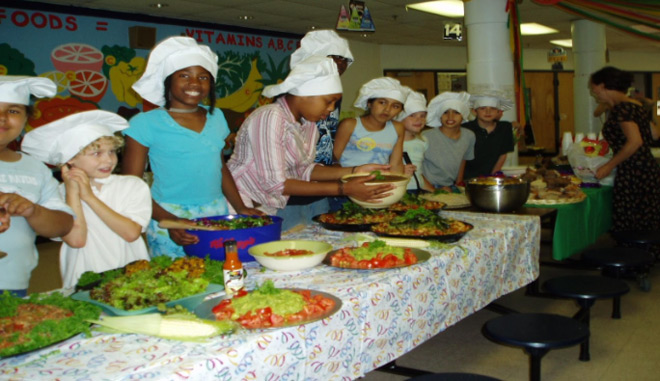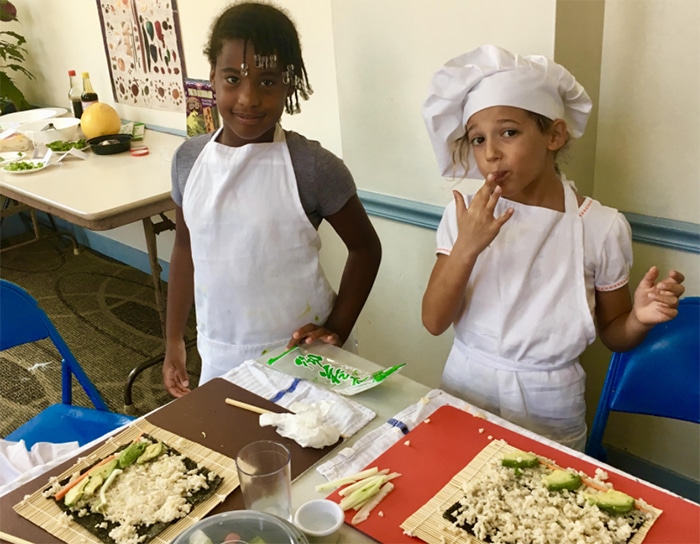

The following is an article from a Community Grant recipient.
How to get kids to eat veggies is a question parents have grappled with for years. But in the last quarter century this issue has become more pressing due to the increase in diet-related diseases like heart disease, diabetes, and cancer that are now afflicting children. For the first time in the U.S., the current generation of kids is expected to have a shorter lifespan than their parents in large part because of what they are eating.
The solution is simpler than you might think. It boils down to creating fun opportunities for kids to learn about healthy foods by touching, smelling, chopping, tasting and growing them with their peers. I know this is true because it’s what happens in my classroom on a daily basis. For over a decade, I have engaged children ages 4 to 14 in hands-on nutrition, cooking, and gardening lessons in a Baltimore City Public School. I have seen thousands of kids devour greens and beans, delight in rolling veggie sushi, persevere with chopsticks, beg for more kale, protest when they find out how many chemicals are in their favorite cereals, and shriek with joy when they spot a praying mantis or lady bug protecting the Three Sisters (corn, beans, and squash) growing in the school garden.
Teaching food literacy in an educational setting is important because it puts food and nutrition on par with reading and math, it’s a welcome break from academic seatwork, it’s a teacher rather than a parent encouraging you to eat your vegetables, you learn skills you can use every day, and the classwork is delicious!
Hands-on food classes also provide an opportunity for multiple intelligences to shine; many students who struggle with academics experience success and leadership in my class. Learning is fun when food is involved. Food provides a great way to bring academic concepts to life. Science and math become tangible through measuring ingredients, finding the circumference of a sushi roll or observing states of matter when boiling or steaming foods.
Students learn geography and social studies through international cooking lessons where they prepare traditional dishes made with indigenous foods. Kids enjoy learning about cultural traditions around the world. Positive exposure to cultural diversity via foodways promotes acceptance of other people. A few days ago, a 7th grader surprised me when he arrived to class and said “As Salaam Alaikum”, an Arabic greeting he learned last year when we made hummus and falafel pita sandwiches and learned about the Middle East. My food literacy classes have increased curiosity and acceptance in my students about the global community.
My school is culturally diverse. The ethnic breakdown of our student body is roughly 20-40-40 White, Black, Hispanic, and the poverty rate is 76%. Disadvantaged children learn alongside children from six-figure incomes. Some children come to our school not knowing English and many students are being raised by a grandparent. All 850 students in preschool through eighth grade are assigned to my class every year. Students can also participate in culinary arts club and garden club after school. Kids in these clubs cook 200 meals for the Community Arts Nights that take place in the Fall, Winter, and Spring. During these events, the band and orchestra perform, there is a student art show, and dinner is served in the cafeteria. Students cook and serve theme-based meals alongside parent volunteers and high school students I used to teach who volunteer to help the younger kids.

Our first community dinner, 2004
The children are also involved in International Night, a celebration of diversity. Last year, a mother from Russia taught kids in culinary arts club how to make a hearty potato and cabbage dish, and several mothers and grandmothers from Mexico taught us how to make both sweet and savory tamales. The students served these foods at International Night, and there were dance performances that provided live entertainment.
In August 2020, FSI was awarded a micro grant by CNS to engage twenty-four families in fun, sensory education about healthy eating during the pandemic. In the Healthy Foods for Healthy Families class, six families at a time will participate in five sequential online classes centered on vitamin-rich foods that promote health. Each family will receive through the grant a grocery bag full of fresh, colorful plant-based whole foods and will learn how these foods affect health as they experience and eat these foods in hands-on activities. From the comfort of their own home via zoom, they will taste and describe each food, and learn to associate specific colors in foods with vitamins with a goal of eating a rainbow of colorful fruits and vegetables every day. After the tasting activity, families will be instructed to safely prepare the foods to create an edible art project representing the body parts nourished by vitamins. For example, a variety of vitamin A-rich foods will be used to create a portrait including eyes, hair, skin and teeth, which are the body parts that require vitamin A. Before eating, families will participate in a virtual “Art Walk” to admire each other’s creations. They will also engage in cooking activities and additional recipes will be provided so families can continue preparing the foods in different ways at home. Based on my experience working alongside parent volunteers and their children at school events, I am confident that the positive food memories created in this class will lead to long-lasting changes in eating behavior and greater acceptance of a variety of plant-based foods.

Vitamin B edible art project made out of vitamin B-rich foods and representing the body parts nourished by vitamin B – the bones and nervous system.
The food literacy program at my school was initiated in 2004 with grants obtained by my mother and mentor, Dr. Antonia Demas, of the nonprofit Food Studies Institute (FSI). My mom did her Ph.D. research at Cornell with Dr. T. Colin Campbell as her nutrition advisor. She has trained and mentored thousands of teachers over the years how to use her award-winning Food is Elementary curriculum, and written hundreds of grants to initiate food literacy programs in schools around the country and abroad.
The goal of FSI is to have a food literacy educator in every school of the country. My public charter school in Baltimore, Hampstead Hill Academy, is the first school in the nation that has made food literacy education a part of every student’s education. When Dr. Demas initiated the program in 2004 she told the principal that she was willing to write grants for three years to get the program established so that others could see it has educational substance. If the school community did not value the program enough after three years of outside funding, she would take the program elsewhere. I am pleased to report that after the first three years of grant funding, the school has paid for the program including my salary and benefits, as well as all food and gardening supplies. Additionally, the principal built a kitchen classroom in a room that previously had no plumbing. It was outfitted with three sinks, a dishwasher, refrigerator, stove, and cupboards. During the first year of operation in 2004 the principal committed paved space to be transformed into the school garden and then two years later doubled the garden space.
The investment has paid off. The food literacy program has changed the eating behaviors of thousands of children and their families over the years. For example, the mother of a preschool student recently asked me how to prepare the eggplant her son had in class, because he kept bugging her to make it. A grandmother told me her granddaughter saved her allowance to buy guacamole ingredients so she could make it with her friend at home. A father of twins proudly shared that his fourth graders had recently cooked a healthy dinner for the family.
Dr. Demas and I feel strongly that food literacy education provides a positive solution to our nation’s health, education, and environmental problems. If we want to prevent children from getting diet-related diseases, we need to educate them on healthy eating, and schools can and should play a vital role. Right now, the food industry is spending millions of dollars marketing to children. Many busy parents don’t have enough time or resources to teach their children how to eat well. Schools can help bridge this gap and give students the knowledge and skills they need for a happy, healthy future.
If you want to get a food literacy program going in your school district or support the work of FSI, please contact Dr. Antonia Demas at foodstudies.org. Also check out her new children’s book SURPRISES IN MILI’S SUITCASE: How Diabetes was Cured with Food, written with and illustrated by Katherine Orr with a foreword by T. Colin Campbell.
The T. Colin Campbell Center for Nutrition Studies (CNS) is committed to increasing awareness of the extraordinary impact that food has on the health of our bodies, our communities, and our planet. In support of this commitment, CNS has created a Community Grant initiative to empower sustainable food-based initiatives around the world by providing grants to enable innovative start-ups and to propel the growth of existing initiatives. Please consider making a donation to this great cause. 100% of your donation will go to support initiatives like the one you just read about in this article.
Copyright 2024 Center for Nutrition Studies. All rights reserved.